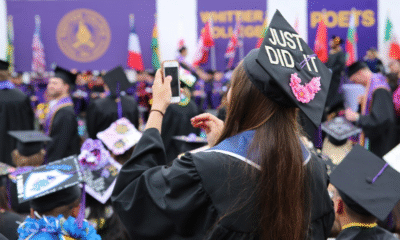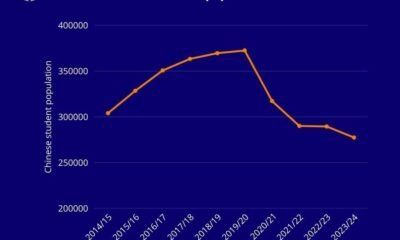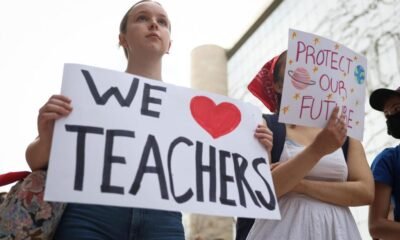Education
the reality of the US student visa system

Min, a student from Bangladesh, remembers his excitement after learning he had been accepted into a US university. It meant he would be learning from some the world’s leading medical experts in healthcare – learning skills he hopes to use to improve the healthcare system in his home country.
Min, who asked not to use his real name due to fears over enhanced US screening policies, was recently granted a visa and is due to start his freshman year this fall.
The road to get there, however, was not a smooth one. Following the State Department’s three-week worldwide pause on interviews in June, and the implementation of enhanced screening policies, many of Min’s peers had their interview appointments delayed.
It took Min three months to secure his required interview at the embassy for his student visa. He said the software used to schedule the interview kept crashing and the embassy had limited appointment times, checking multiple times a day for openings.
While Min saw his visa approved, several of his friends had their student visas denied at the end of their interview, he said, leading some of them to apply for universities in other countries. Most often, it’s another English-speaking country, since that’s the most common secondary language for Bangladeshi students, he said.
“In recent, years, a lot of my friends have applied to Australia, because for the US, there are more uncertainties,” Min said.
The student visa application process has come into the spotlight recently. That’s because of the Trump administration’s changes to how visa officers review students’ social media activity. Some visa applicants have expressed concerns that the policies could lead to an increase in visa denials.
However, education nonprofits have for years raised alarms about high rates of visa denials and long interview wait times – warning it could hinder the global competitiveness of US higher education.
Visa denials differ for world regions
The US State Department rejected over 650,000 student visa applications worldwide from 2018 through 2022. Students from developing nations in South Asia and Africa have their visas rejected at much higher rates compared to those from wealthier countries.
That’s according to a study that looked at eight years’ data – authored by The Presidents’ Alliance and Shorelight student support company. The report shines a light on experiences of students from Asia and Africa, who struggle with long wait times to schedule visa interviews.
For European students who apply to study in the US, getting denied entry is rare – fewer than 8% in 2023, according to the study. That’s a stark difference from Africa, where 61% of students were denied a visa that year, not including South Africa and some neighbouring countries with very low denial rates. For South Asia, including Nepal, between 36% and 55% students have their visas denied each year.
The world’s population of young, smart minds is exploding out of sub-Saharan Africa
Carly O’Keefe, Monroe Community College, Rochester
Rajika Bhandari, a senior advisor with the Presidents’ Alliance who led the study, said the findings reflect patterns that college administrators have noticed for decades.
“From the campus perspective, these students have been fully vetted and deemed worthy of being offered admission,” said Bhandari, once a US international student herself. “Yet they’re facing this final barrier.”
A visa officer decides whether to grant a student entry after interviewing them at an embassy or consulate. One goal of the interview, lasting several minutes at most, is to assess whether the student is likely to return to their homeland after graduating.
If the student can’t demonstrate strong homeland connections – such as through owning property, having a job lined up after graduation, or strong family ties – it can be grounds for denial. The visa officer will also review documents showing the student’s eligibility to study internationally, including financial statements showing the student can afford college.
Many students, Bhandari said, have expressed concerns to college leaders that they’ve met every requirement but are still denied – leaving them bewildered. Visa officers rarely share the specific reason for the denial with applicants.
“You may go back a second time and be denied yet again because you don’t know what it is that you need to fix,” Bhandari said.
The State Department didn’t directly respond to a request for comment but has said in the past that it’s committed to a fair visa review process. The department said that applications, especially from Africa, have skyrocketed in the past few years and “a commensurate increase in denials is expected.”
According to the department, more visas were issued to African students in 2023 than ever before, with Nigerian students granted the highest share. However, the visa denial rate for African students grew that year by three percentage points, according to the study, while the denial rate for European and South American students dropped.
The State Department doesn’t publish data on visa denials but does disclose how many student visas are issued for each country every month. So far this year, the number of F-1 visas issued for Nigerian students is 23% less compared to this time last year, based on data published through May. For Bangladeshi students, like Min, the number of visas issued is about the same as last year.
Experience with getting a visa denied
Sooraj Sahani, entering his sophomore year at Texas State, knows how confusing and emotional it can be to have a visa denied. He had his visa denied on the first try, before applying again and getting it approved three weeks before the start of freshman year in fall of 2024.
In his village in the plains of Nepal, Sahani fed his fascination for physics by taking online classes from some of the world’s top experts. He aspired to be like the professors who mentored him virtually through the World Science Scholars program, a nonprofit based in New York City. That’s why Sahani decided he wanted to study at a US university, determined to become a theoretical physics researcher.
When he learned that Texas State was offering him a full undergraduate scholarship, he thought he was on track to fulfil his dream. His scholarship meant the US couldn’t deny his student visa for financial reasons, Sahani said. But he still ran into issues.
When Sahani tried last summer to book a visa interview appointment for the US embassy in Kathmandu, Nepal, all the slots were full for weeks. Instead, he traveled to New Delhi for an interview with a visa officer. Sahani said that, at the end of the roughly one-minute interview, the officer told him he wasn’t eligible for a visa without any explanation.
Students can wait up to nine months for a US visa interview in Dhaka, Bangladesh
US State Department data
“With a very sad face, I had to come back from India. It took me some time to tell myself that, OK, it happens. I’m not giving up,” he said.
After getting his visa denied, Sahani scheduled his second visa interview appointment at the embassy in Kathmandu. To secure a slot, he repeatedly woke up in the middle of the night to check online for appointments.
“I woke up at 2am, 3am, 4am, just to see if there was a visa slot. We have a lot of students applying for the US but we just have one embassy,” he said.
Since releasing its study, the Presidents’ Alliance and other education nonprofits have met with State Department leaders about improving visa processing. The department says it’s made progress in lowering wait times worldwide by hiring more staff and giving visa officers the authority to waive some interviews.
However, some countries still have too few embassies or staff members to keep up with the high number of students, Bhandari said. For the embassy in Dhaka, Bangladesh, it’s currently a nine month wait time for a student visa interview, according to the department’s website.
“Academic loss and economic loss”
Higher education leaders warn that if visa issues persist, they’ll hinder the US’s global competitiveness. In January NAFSA wrote a letter to the incoming Trump administration calling for action to make visa processing times more predictable. The letter also advocates for creating a pathway for international students to become permanent residents after graduation, which, according to Bhandari, may help to address visa denials.
If students can choose to live and work in the US after graduation, they wouldn’t have to prove their intentions to return to their home country – a source of many denials. In April, Congress introduced the Keep STEM Talent Act with bipartisan support, aiming to create this kind of “dual intent” pathway for international students pursuing science, technology, or maths degrees. Most of the 1.1 million international students who came to the US last academic year chose STEM fields.
The high rate of visa denial for African students is both an academic loss and an economic loss, said Carly O’Keefe, the designated school official for international student enrolment at Monroe Community College in Rochester, NY.
Like many other states, college enrolment in New York has been declining. New York’s comptroller warns that 2025 could mark the start of an “enrolment cliff” – a sharp decline in applications reflecting the steady decline in US births since a historic high in 2007. Several colleges in the state have closed in recent years due to low enrolment.
Meanwhile, Africa’s young population is increasing. By 2050, Nigeria is expected to become the world’s third most populous country, behind only India and China. Africa isn’t just full of college-aged youth, O’Keefe said, but also innovation led by youth. As technology is becoming more available in Africa, the number of youth-led startups is booming.
“The world’s population of young, smart minds is exploding out of sub-Saharan Africa,” she said. “Just think of the brain power and the potential talent in the world.”
Last fall, MCC welcomed about 90 international students, the most since 2018, from 30 countries. However, as with most colleges that host international students, the number enrolled was fewer than the number who planned to come because of visa denials. Colleges across the US, O’Keefe said, are missing out on talent because of the denials.
“We’re potentially missing out on very qualified students enrolling at our colleges and universities across the country that could be doing amazing academic work,” she said.
Education
College president fears that federal education cuts will derail the promise of student parents, student military veterans and first-gen students

As a college president, I see the promise of higher education fulfilled every day. Many students at my institution, Whittier College, are the first in their families to attend a university. Some are parents or military veterans who have already served in the workforce and are returning to school to gain new skills, widen their perspectives and improve their job prospects.
These students are the future of our communities. We will rely on them to fill critical roles in health care, education, science, entrepreneurship and public service. They are also the students who stand to lose the most under the proposed fiscal year 2026 federal budget, and those who were already bracing for impact from the “One Big Beautiful Bill” cuts, including to the health care coverage many of them count on.
The drive with which these extraordinary students — both traditionally college-aged and older — pursue their degrees, often while juggling caregiving commitments or other responsibilities, never fails to inspire me.
Related: Interested in innovations in higher education? Subscribe to our free biweekly higher education newsletter.
We do not yet know the precise contours of the spending provisions Congress will consider once funding from a continuing resolution expires at the end of September. Yet we expect they will take their cues from the president’s proposed budget, which slashes support for students and parents and especially hammers those already struggling to improve their lives by earning a college degree, with cuts to education, health and housing that could take effect as early as October 1.
That budget would mean lowering the maximum Pell Grant award from $7,395 to $5,710, reversing a decade of progress. For the nearly half of Whittier students who received Pell Grants last year, this rollback would profoundly jeopardize their chances of finishing school.
So would the proposal to severely restrict Federal Work-Study, which supports a third of Whittier students according to our most recent internal analysis, and to eliminate the Supplemental Educational Opportunity Grant, which more than 16 percent of our student body relies upon. In addition, this budget would impose a cap on Direct PLUS Loans for Parents, which would impact roughly 60 percent of our parent borrowers. It would also do away with the Direct PLUS Loans for Graduates program.
These programs are lifelines, not just for our students but for students all across the country. They fuel social mobility and prosperity by making education a force for advancement through personal work ethic rather than a way to rack up debt.
If enacted, these proposed cuts would gut the support system that has enabled millions of low-income students to earn a college degree.
Higher education is a bridge. To cross it and achieve their full potential, students from all walks of life must have access to the support and resources colleges provide, whether through partnerships with local high schools or with professional gateway programs in engineering, accounting, business, nursing, physical therapy and more. Yet, to access these invaluable programs, they must be enrolled. How will they reach such heights if they suddenly can’t afford to advance their studies?
The harm I’ve described doesn’t stop with cuts to financial aid, loans and services. Proposed reductions also target research funding for NASA, NIH and the National Science Foundation. One frozen NASA grant has already led to the loss of paid student research fellowships at Whittier, a setback not just in dollars but in momentum for students building real-world skills, networks and résumés.
These research opportunities often enable talented first-generation students to connect their classroom learning to career pathways, opening the door to graduate school, lab technician roles and futures in STEM fields. We’ve seen how federal funding has supported student projects in everything from climate data analysis to environmental health.
Stripping away support for hands-on research undermines the federal government’s own calls for colleges like ours to better prepare students for the workforce by dismantling the very mechanisms that make such preparation possible.
It’s particularly disheartening that these changes will disproportionately hurt those students who are working the hardest to achieve their objectives, who have done everything right and have the most to lose from this lack of investment in the future.
The preservation and strengthening of Pell, Work-Study, Supplemental Educational Opportunity grants and federal loan programs is not a partisan issue. It is a moral and economic imperative for a nation that has long been proud to be a land of opportunity.
Let’s build a system for strivers that opens doors instead of slamming them shut.
Let’s recommit to higher education as a public good. Today’s students are willing to work hard to deserve our continuing belief in them.
Kristine E. Dillon is the president of Whittier College in California.
Contact the opinion editor at opinion@hechingerreport.org.
This story about education cuts was produced by The Hechinger Report, a nonprofit, independent news organization focused on inequality and innovation in education. Sign up for Hechinger’s weekly newsletter.
Education
Pupils in England from low-income families ‘bounced out’ of costlier GCSEs | Secondary schools

Secondary school pupils from low-income families are “bounced out” of studying subjects such as geography and languages because of fears about extra costs, according to a survey of children in England.
Nearly a quarter (23%) of those surveyed who were in receipt of free school meals (FSM) said the cost – or worries about the cost – prevented them from choosing certain GCSE subjects, compared with just 9% of non-FSM pupils.
Costs associated with geography field trips and modern foreign language visits make it difficult for the most disadvantaged students to pursue these subjects.
Other subjects with additional costs include music, because of instrument lessons, food and nutrition, which requires ingredients, and PE, due to the extra kit and equipment required.
Almost a third (30%) of FSM students said their families already struggle to afford the basics they need for homework, including access to technology and devices.
The survey of more than 1,000 students, which was conducted by Survation for the Child Poverty Action Group (CPAG), revealed stark differences between pupils on FSM and their non-FSM peers.
Secondary pupils on FSM are nearly twice as likely as their better-off peers to say their family’s income makes it harder for them to learn at school (15% v 8%). They are also more likely to say it is difficult to afford pens and pencils (14% v 8%).
Of those children in receipt of FSM, a third (34%) said it is difficult to afford school trips and a fifth (21%) struggle to pay for clubs, while more than a quarter (27%) said it is difficult to afford musical instruments or instrument tuition
CPAG’s head of education policy, Kate Anstey, said: “Children in struggling families are going back to school only to be bounced out of some subjects and learning by costs – cut off from opportunities just as the foundations of their futures are being laid.
“The prime minister has promised to leave ‘no stone unturned to give every child the very best start at life’ but actions are needed to match that objective. Government’s forthcoming child poverty strategy must invest in family incomes and children’s life chances – and scrapping the two-child limit must be the first action point.”
It costs parents of secondary schoolchildren a minimum of £2,275 a year to send a child to school, according to earlier CPAG research, of which £450 goes on learning materials including stationery, revision guides and calculators.
Labour’s flagship child poverty strategy was originally due to be published in the spring, but was delayed amid continuing debate about the cost implications of ending the two-child benefit cap.
The cap, which limits parents to claiming many means-tested benefits for their first two children, apart from in very limited circumstances, was introduced under the Conservatives. Experts say scrapping it would be the single most effective way of reducing child poverty.
A Department for Education spokesperson said: “We are absolutely clear that schools should make sure the cost of curriculum subjects is not a barrier to access and that materials necessary for examinations are provided to all pupils.
“More widely, we are putting pounds back in parents’ pockets by limiting the number of branded uniform items, expanding free school meals to every family on universal credit and rolling out free breakfast clubs across the country.”
Education
Australia’s teen social media ban can be ‘effective’, report says

Australia could use a range of technologies to implement its social media ban for under-16s but all have risks or shortcomings, a report has found.
The government says its ban, which comes into effect in December, is designed to limit the harmful impacts of social media. The policy has been touted as a world-first and is being watched closely by leaders globally.
Under the new laws, platforms must take “reasonable steps” to prevent Australian children from creating accounts on their sites, and deactivate existing ones.
Though the move is popular with many parents, experts have raised concerns over data privacy and the accuracy of age verification technology.
The federal government commissioned the UK-based Age Check Certification Scheme to test the ways Australia could enforce the ban, and its final report was published on Sunday.
It looked at a variety of methods – including formal verification using government documents, parental approval, or technologies to determine age based on facial structure, gestures, or behaviours – and found all were technically possible.
“But we did not find a single ubiquitous solution that would suit all use cases, nor did we find solutions that were guaranteed to be effective in all deployments,” it said.
Verification using identity documents was cited as the most accurate method, but the report identified concerns that platforms may keep this data longer than required and was anticipating sharing it with regulators, both of which would leave users’ privacy at risk.
Australia – like much of the world – has in recent years seen a series of high-profile data breaches, including several where sensitive personal information was stolen and sold or published.
Facial assessment technology was 92% accurate for people aged 18 or over, but there is a “buffer zone” – about two to three years either side of 16 – in which is it is less accurate. The report said this would lead to false positives, clearing children for accounts, and false negatives, barring users who should be allowed.
There are also privacy and accuracy concerns with parental approval methods, it said.
It recommended that the methods should be “layered” to create the most robust system, and highlighted that many of the technology providers were looking at ways to address circumvention, through things like document forgeries and VPNs (virtual private networks) which obscure the user’s country.
Communications Minister Anika Wells said there was “no one-size-fits-all solution”, that the report showed age checks could be “private, efficient and effective”.
“These are some of the world’s richest companies. They are at the forefront of AI. They use the data that we give them for a bevy of commercial purposes. I think it is reasonable to ask them to use that same data and tech to keep kids safe online,” she told reporters on Monday.
“There is no excuse for social media platforms not to have a combination of age assurance methods in their platforms ready for 10 December.”
Under the ban, tech companies can fined up to A$50m ($32.5m; £25.7m) if they do not take “reasonable steps” to bar those aged under 16 from holding accounts. These steps are still to be defined.
Facebook, Instagram, Snapchat and YouTube are among the platforms affected.
Polling indicates most Australian adults support banning social media for children under 16.
However some mental health advocates say the policy has the potential to cut kids off from connection, and others say it could push children under 16 to even-less-regulated corners of the internet.
They suggest the government should instead focus on better policing of harmful content on social media platforms and preparing children for the reality of life on the web.
-

 Business3 days ago
Business3 days agoThe Guardian view on Trump and the Fed: independence is no substitute for accountability | Editorial
-
Tools & Platforms3 weeks ago
Building Trust in Military AI Starts with Opening the Black Box – War on the Rocks
-

 Ethics & Policy1 month ago
Ethics & Policy1 month agoSDAIA Supports Saudi Arabia’s Leadership in Shaping Global AI Ethics, Policy, and Research – وكالة الأنباء السعودية
-

 Events & Conferences3 months ago
Events & Conferences3 months agoJourney to 1000 models: Scaling Instagram’s recommendation system
-

 Jobs & Careers2 months ago
Jobs & Careers2 months agoMumbai-based Perplexity Alternative Has 60k+ Users Without Funding
-

 Funding & Business2 months ago
Funding & Business2 months agoKayak and Expedia race to build AI travel agents that turn social posts into itineraries
-

 Education2 months ago
Education2 months agoVEX Robotics launches AI-powered classroom robotics system
-

 Podcasts & Talks2 months ago
Podcasts & Talks2 months agoHappy 4th of July! 🎆 Made with Veo 3 in Gemini
-

 Podcasts & Talks2 months ago
Podcasts & Talks2 months agoOpenAI 🤝 @teamganassi
-

 Mergers & Acquisitions2 months ago
Mergers & Acquisitions2 months agoDonald Trump suggests US government review subsidies to Elon Musk’s companies





















